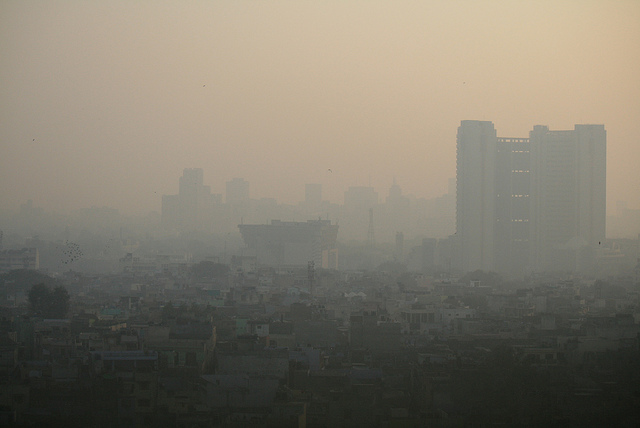Podcast: Play in new window | Download
Subscribe: RSS

The air in Delhi, shown here in 2011, like the air in Beijing, is barely breathable by humans. Yet these two countries, with their 2.6 billion people, have just begun to burn fossil fuels. (Photo by je poirrier/Flickr)
Hopium addicts and a few novelists nurture the convenient belief that while the 1.4 billion people of China and the 1.2 billion people of India struggle lustfully to live as luxuriously as do the 300 million people of the United States, they will manage to do so in a manner somehow less wasteful of energy and natural resources, less destructive of the living web of life, than we have done. The belief is convenient because, while there is not a whisker of evidence to suggest it is true, holding it permits the believer to carry on with business as usual.
Much has been made of the “historic” agreement reached between China and the United States at the recent APEC meeting in Beijing, stipulating that in the next 10 years or so, both countries are going to do something or other about carbon emissions (i.e. pollution), so help them. Yet the Chinese did not begin to attack the air pollution in Beijing, which may be the worst in the world, until the eve of the meeting; then and only then did it become a national priority, not because it was bad but because it looked bad.
They ordered factories upwind of the capital shut down, closed businesses and schools in the city and banned half the region’s cars from driving, all to look good, knowing that as soon as the meeting was over, so were the restrictions. It did not work very well, of course, the world is not a machine that responds immediately to the pulling of a few levers. And one of the reasons it did not work was that, as an investigating committee discovered on venturing into the region where the factories had been ordered to close, they did not. Screw Beijing, there were targets to meet, bonuses to be made, orders to fill. So much for how much better they are going to be at regulating pollution.
China still pretends that it is cracking down on pollution, even while building dirty, coal-burning electric plants as fast as it can — it opens a new one every seven to 10 days and as of two years ago had 363 projects under way. It already burns six times as much coal as does the United States, is the world’s largest importer of coal, and coal is the source of the majority of its air pollution.
India, on the other hand, is in the process of dropping all pretenses that it is combatting pollution. Within days of the election last summer of the new pro-business, pro-growth prime minister Narendra Modi (who was almost immediately received and extolled in a state visit to Washington), India’s industrialists got the word: environmental rules were about to be relaxed and in the meantime, feel free to ignore them.
Since then a government commission has recommended that government inspections of the performance of factories in controlling pollution be replaced with a system of voluntary compliance in which everyone promises to obey the rules and report themselves if they don’t. Approval of new projects, no matter how destructive, has become not only virtually automatic, but has been accelerated to warp speed: a recent meeting of the National Board for Wildlife smiled upon 150 wildlife-threatening applications in two days, spending up to 30 minutes on each.
Neither China nor India has any intention of improving upon the path to prosperity that we have shown them. As we seem to believe that God has favored us, so they seem to believe that Krishna and Mao have bestowed upon them the right to burn and degrade and destroy anything that can contribute to their temporary well being.
The problem is that there is not that much left to burn. Hoping that the world’s two largest and poorest populations are going to be more restrained in their instant gratification. more successful in reining in greed, than we have been, well, that is hopium indeed.
It’s a historical tragedy that, instead of the West being converted to the teachings of Confucius and the Buddha, it should be the East being converted — along with well nigh all of the rest of humanity — by the towering intellect of the founders of modern industrial civilization. With the results now all in plain sight. :)
SomeoneInAsia: I hear that! All the religious leaders, artists, poets and philosophers over the years that pointed out that we’re going the “wrong way” as a species (for a very long time) – none of them was heeded. Well, now we learn the HARD way.
Our clock is ticking…
‘Accelerating Towards an Arctic Blue Ocean Event’
http://collapseofindustrialcivilization.com/2014/12/08/accelerating-towards-an-arctic-blue-ocean-event/
“Even if you discount the methane, we’re in deep shit once the Arctic sea becomes ice free during the summer, most likely in the month of September by 2020. This will allow a window into which solar energy can warm the waters and greatly amplify runaway Arctic warming, further changing the jet stream and ocean currents. We don’t need the methane wild card for this to be a civilization-ending process.”